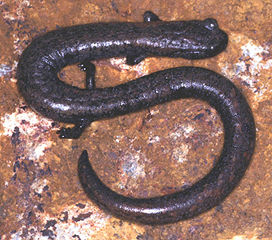- Home
- About S&T
- Taxa/Organisms
- Ecosystems
- Issues
- Methods & Tools
- Reports & Publications
- Location
- Search
Publisher: USGS | Science Center: Patuxent Wildlife Research Center (PWRC, Laurel) | Format: URL
igsaceeswb00.er.usgs.gov:8080 — From the Web site: "The Amphibian Research and Monitoring Initiative (ARMI) National Atlas for Amphibian Distributions (or simply, the ARMI Atlas), is a compilation of current and historic records of amphibian occurrences. These records are from published, peer-reviewed scientific literature, museum records, state and regional herpetological More...

Publisher: USGS | Format: URL
armi.usgs.gov — The U.S. Geological Survey's Amphibian Research and Monitoring Initiative (ARMI) is a multidisciplinary effort to determine the status and trends of amphibians in the U.S., research the causes for amphibian declines, and provide scientific information to decision-makers to help halt or reverse declines. This website includes information on ARMI's More...

Publisher: USGS | Science Center: Forest and Rangeland Ecosystem Science Center (FRESC, Corvallis) | Format: URL
fresc.usgs.gov — ARMI is an initiative of agencies within the United States Department of the Interior to measure, understand, and respond to effects of environmental change upon the Nation's amphibians. Amphibians have been disappearing from many locations around the world and reports of declines have increased in recent decades. Some of the most dramatic More...

Publisher: USGS | Science Center: National Wetlands Research Center (NWRC, Lafayette) | Format: URL
www.nwrc.usgs.gov — The south-central region includes the States of Texas, Oklahoma, Arkansas, Mississippi, and Louisiana. We are currently conducting research projects designed to monitor amphibians on Federal lands in these States and to research possible causes of declines in amphibian populations. These potential threats include loss or degradation of habitat, More...

Publisher: USGS | Science Center: Northern Prairie Wildlife Research Center (NPWRC, Jamestown) | Format: URL
www.npwrc.usgs.gov — Interest in amphibians continues to rise as people become more aware of this fascinating group of animals. To the uninitiated all frogs may look alike; ditto for salamanders (in the same manner that beginning birders are overwhelmed by the immense variety of small brown birds). One of the purposes of this checklist and online identification guide More...

Publisher: USGS | Science Center: Fort Collins Science Center (FORT, Ft. Collins) | Format: URL
www.fort.usgs.gov — At high elevations, and in the nearby Capitan and White mountains in alpine tundra habitat, the Sacramento Mountain salamander occurs. This issue overview looks at size-class distributions of salamanders, showing that juveniles comprise a significantly smaller proportion of all salamanders on logged plots, suggesting that populations on logged More...

Publisher: USGS | Science Center: Forest and Rangeland Ecosystem Science Center (FRESC, Corvallis) | Format: URL
fresc.usgs.gov — The National Park Service has stated that declining amphibian populations are the top priority for research in the National Park System. Salamanders are a native vertebrate predator in small, western, high-mountain lakes naturally barren of fish. During this century many western high-mountain lakes were stocked with trout. These introduced fish More...

Publisher: USGS | Science Center: Forest and Rangeland Ecosystem Science Center (FRESC, Corvallis) | Format: URL
fresc.usgs.gov — Description of a project to determine the status of reptiles and amphibians at Olympic National Park. Includes project objectives, metadata, related publications, and contact information.

Publisher: USGS | Science Center: Forest and Rangeland Ecosystem Science Center (FRESC, Corvallis) | Format: URL
fresc.usgs.gov — There is a relatively rich herpetofauna in southwestern Oregon with about 38 species present. These species are almost equally divided between amphibians and reptiles. The objective of this issue overview is to conduct field surveys and assess status of several amphibian species of management concern, including: Western toad (Bufo boreas), Cascade More...

Publisher: USGS | Format: URL
pubs.usgs.gov — The steps necessary to conduct a pitfall trapping survey for small terrestrial vertebrates are presented. Descriptions of the materials needed and the methods to build trapping equipment from raw materials are discussed. Recommended data collection techniques are given along with suggested data fields. Animal specimen processing procedures, More...

Publisher: USGS | Science Center: Western Ecological Research Center (WERC, Sacramento) | Format: URL
www.werc.usgs.gov — This site is a field guide to the reptiles and amphibians of coastal Southern California, including species accounts, illustrations of tadpoles, and images of different habitat types. The guide also contains a glossary of terms, a map of the study area, and types of habitats.

Publisher: USGS | Science Center: Forest and Rangeland Ecosystem Science Center (FRESC, Corvallis) | Format: URL
fresc.usgs.gov — An overview of research that defines the distribution and habitat requirements of amphibians and reptiles in southern Oregon, mostly in old-growth forests or alpine habitats. Includes links to USGS publications resulting from this research.
